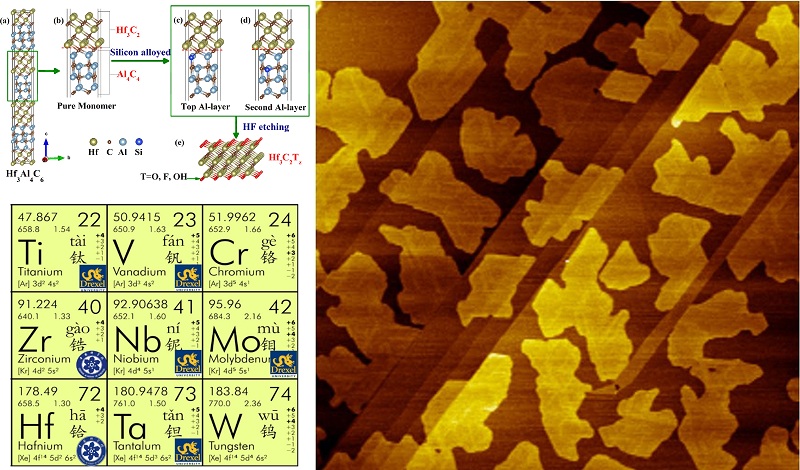MXenes, as a new family of two-dimensional (2D) materials have attracted increasing attentions in recent years since their discovery in 2011. Approximate twenty MXenes have been synthesized up to date, which include Ti3C2Tz, Ti2CTz, Ta4C3Tz, (Ti0.5Nb0.5)2CTz, (V0.5,Cr0.5)3C2Tz, Ti3CNTz, Nb2CTz,V2CTz, Nb4C3Tz, Mo2TiC2Tz, Mo2Ti2C3Tz, Cr2TiC2Tz, Mo2CTz, Ti4N3Tz, Mo2ScC2Tz , (Nb0.8Ti0.2)4C3Tz, (Nb0.8Zr0.2)4C3Tz. These MXenes were determined to present high specific areas, favorable conductivity and hydrophilicity.
Moreover, it was found that the cations can spontaneously intercalate into the MXene layers. In addition, theoretically many MXenes were predicted to possess strong elastic moduli and high carrier mobility. Based on above fascinating properties, MXenes were demonstrated to show widespread potential applications in energy storage, reinforcement for composites and conductive materials, and etc.
In general, MXenes are synthesized by etching corresponding Al-containing MAX phases (M denotes an early transitional metal, A is group13 or 14 elements of the periodic table, X is C and/or N). However, it’s still a challenge to synthesis the Al-containing MAX phases for transitional metals zirconium and Hafnium, which restricts the preparations of the Zr- or Hf-based MXenes. On a different track, our laboratory adopted the hydrofluoric acid to etch a new layered compound Zr3Al3C5 instead of the MAX phase in fabricating of MXenes. The weak bonded Al3C3 units in Zr3Al3C5 were etched out, and we firstly obtained the Zr-based MXene Zr3C2Tz. This matiaerl was determined to show high thermodynamical stable at least up to 1200 ?C. This work was published in Angewandte Chemie-International Edition 128, 5092, 2016.
In contrast to Zr3Al3C5, it’s more difficult to synthesis a single phase for Hf-based layered carbides, and our sintering products generally are mixed phases composed by Hf3Al3C5, Hf3Al4C6 and Hf2Al4C5. Due to the relatively strong sublayer adhesion, the etching product is mainly cubic HfC phase through etching the mixed phases. Therefore, it’s critically important to weaken the sublayer adhesion between the Hf-C and Al-C sublayer in the precursors. Based on the thinking of manipulating the sublayer adhesion through solid solution, a small amount of silicon at the aluminium sites was adopted. Then, we obtained a mixed phase which was mainly the Hf3(Al, Si)4C6 phase combined with a little Hf2(Al, Si)4C5. Using this solid solution as precursor, the Hf-based MXene Hf3C2Tz was developed. Through analysis on the atomic charge and adhesive energy, the underlying mechanism of the Si-alloying-facilitated etching could be ascribed to the more valance electrons of Si than Al which weakened the adhesive energy of the etching interface. This 2D Hf-containing MXene material showed reversible volumetric capacities of 1567 mAh cm-3 and 504 mAh cm-3 for lithium and sodium ions batteries, respectively, at a current density of 200 mAg-1 after 200 cycles. Thus, this MXene is a candidate anode material for metal-ion intercalation, especially for applications where size matters. This work was published in ACS Nano DOI: 10.1021/acsnano.7b00030.
Additionally, collaborated with Prof. Chunyi Zhi of City University of Hong Kong, our laboratory had successfully prepared the quantum-dot-like Ti3C2Tx. This material possessed promising fluorescence characteristic and favorable biocompatibility, which showed potential applications in biomarkers and photothermal therapy. This work was published in Advanced Materials 29, 1604847, 2017 .
The above works were supported by the National Natural Science Foundation of China (Grant Nos. 21671195, 11604346, 51502310, 21577144 and 91426304) and the key technology of nuclear energy, 2014, CAS Interdisciplinary Innovation Team.

PhD candidate Miss Jie Zhou :zhouj@nimte.ac.cn
Associate Professor Dr. Xian-Hu Zha :zhaxianhu@nimte.ac.cn
Professor Dr. Shiyu Du : dushiyu@nimte.ac.cn
Professor Dr. Qing Huang : huangqing@nimte.ac.cn
All Images by ![]()

